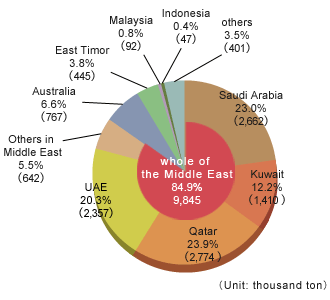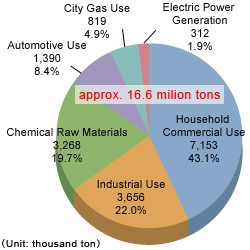Supply
Import Volume by Countries(2009)

Approximately 70% of the LP gas consumed in Japan is imported from overseas, while the remaining approximately 30% is generated domestically when crude oil is refined and when petrochemical products are produced. Imported and domestically produced LP gas is transported from primary facilities by coastal tanker ships and tank lorries (tanker trucks) to secondary facilities, and then filled into compressed gas cylinders for residential use and distributed to residential customers.
Approximately 85% of the imports come from the Middle East, primarily from Saudi Arabia and UAE (United Arab Emirates). Note that in recent years there has been an increase in the volume of imports from newly developed natural gas fields in Southeast Asia such as East Timor and in the Oceania region.
Strategic Stockpile Structure
Japanese law mandates the stockpiling of oil and LP gas (there is no mandate for natural gas). Of the stockpiles, there are private sector stockpiles and government stockpiles, and in the case of LP gas, the import volume of 50 days worth is required to be stockpiled by the private sector. In addition, there are five state-operated facilities (including two under construction) and when all facilities become fully operational the stockpiles are scheduled to reach 1.5 million tons, or 50 days worth of import volume. In combination with private sector stockpiles, a total of 95 days worth (about 3 million tons) will have been secured.
Public and Private Sector Stockpile Volume

Demand
Domestic demand is approximately 16.6 million tons (FY 2009), accounting for approximately 5% (FY 2008) of the final domestic energy consumption.The purposes for which LP gas is used, in addition to household commercial use, are automobile use, industrial use, chemical raw materials, and city gas and electric power generation.
Demand by Sectors(2009)

Household Commercial Use
LP gas is used by roughly half of all households, or approximately 25 million household units. It is chiefly used for gas ranges and hot water heaters, portable gas burners, and the like, and recently portable generators and farm tractors and the like have been taking advantage of the merits of LP gas for a diverse range of equipment now on the market.
Household Commercial Use
LP gas is used by roughly half of all households, or approximately 25 million household units. It is chiefly used for gas ranges and hot water heaters, portable gas burners, and the like, and recently portable generators and farm tractors and the like have been taking advantage of the merits of LP gas for a diverse range of equipment now on the market.
Industrial Use
Primary uses are for heating in metal and nonferrous metal processing and a wide variety of component and foodstuff dehydration. Additionally, agricultural uses are found in supplying carbon dioxide gas in cultivation facilities as well as for heating.
City Gas Use
The chief component of city gas is presently natural gas, but LP gas is also mixed into the formula to adjust the calorific value when the calorific value of natural gas alone is too low.
Automotive Use
LP gas automobiles (LPG cars) that are fueled by LP gas enjoy a favorable reputation for the relatively clean exhaust fumes and their economical merits, and have been making inroads into commercial uses as taxis and delivery vehicles. At present, more than 90% of taxis are LPG cars.
Chemical Raw Materials
Used mainly as raw material in chemical products such as propylene and ethylene.
Electric Power Generation
Although it accounts for only a minor percentage, LP gas is used as a backup fuel in thermal power stations.
Policy Measures
Japan's energy policies are regulated by the specific stipulations of the "Basic Energy Plan" and the "Basic Act on Energy Policy " on which the Plan is based. The Plan ranks LP gas as " the relatively clean gas-energy which emits the cleanest exhaust in terms of CO2 among all fossil fuels" to be "promoted for use as contributing to the materialization of a low carbon society," and expresses the promotion of national stockpile facilities, expansion of the use of biogas, promotion of the diffusion of cogeneration systems such as fuel cells and the like, and various other policy measures.
Furthermore, in the "Primary Energy Supply Roadmap" proclaimed by the Ministry of Economy, Trade and Industry in June 2010, it is speculated that while fossil fuels such as oil and coal will be greatly reduced by the year 2030, LP gas will remain constant at the FY 2007 level.
Primary Energy Supply Roadmap
(unit: equivalent to 1 million kiloliters of crude oil)
| FY 2007 | FY 2030 | Comparison: 2007 v. 2030 | |||
|---|---|---|---|---|---|
| Actual results | Ratio | Actual results | Ratio | ||
| Renewable energy | 35 | 6.0% | 67 | 12.9% | 191.4% |
| Nuclear energy | 60 | 10.1% | 122 | 23.5% | 203.3% |
| Natural gas | 105 | 17.7% | 80 | 15.6% | 76.2% |
| Coal | 130 | 21.9% | 87 | 16.9% | 66.9% |
| LPG | 18 | 3.1% | 18 | 3.4% | 100.0% |
| Oil | 244 | 41.2% | 143 | 27.7% | 58.6% |
| Total | 592 | 517 | 87.3% | ||
(Source: Ministry of Economy, Trade and Industry)

